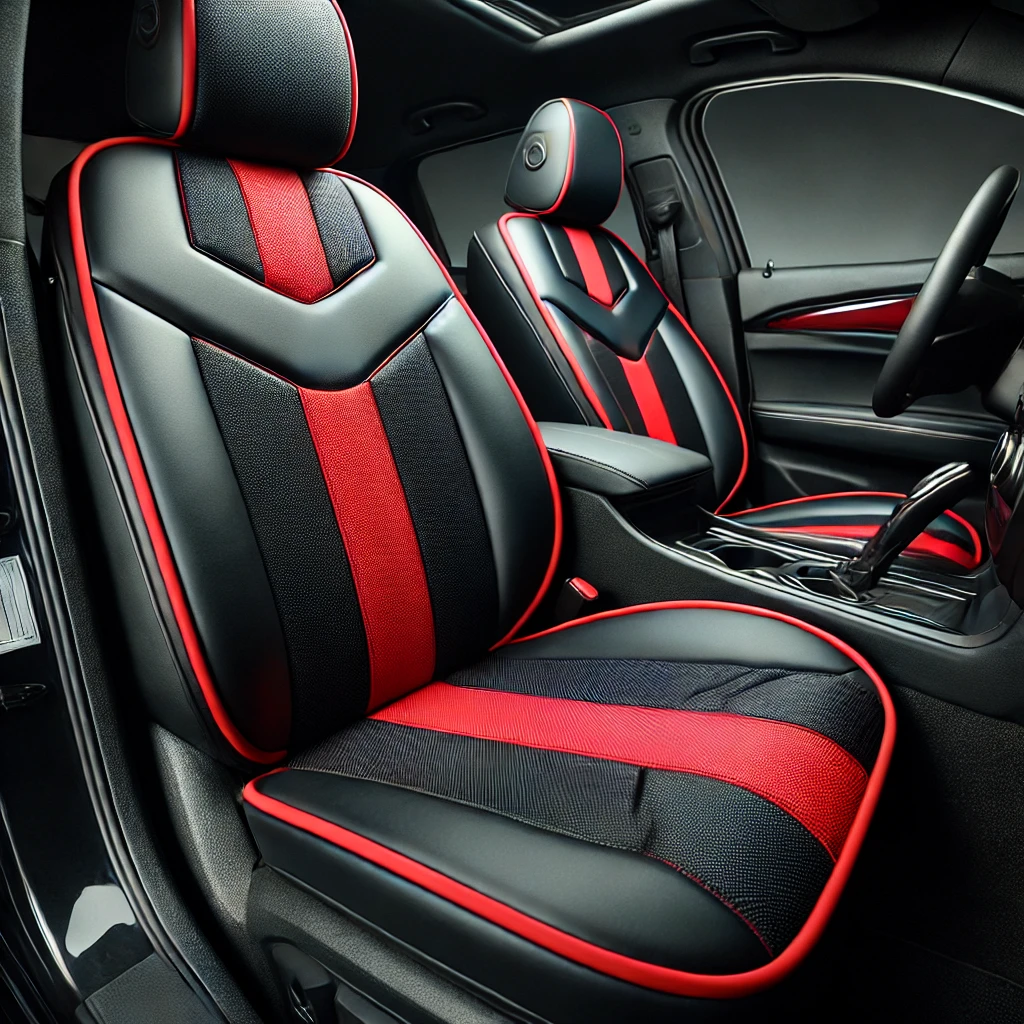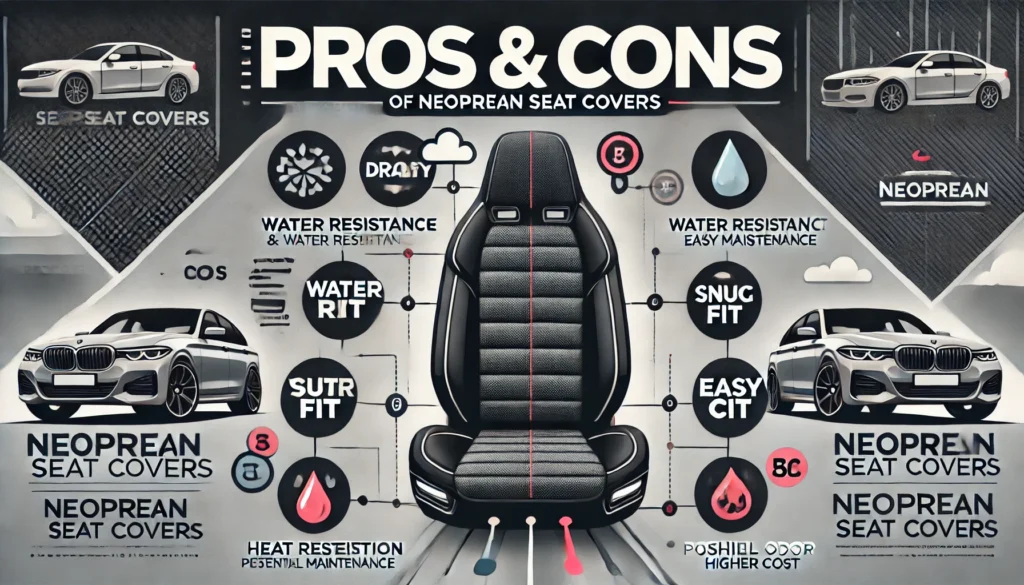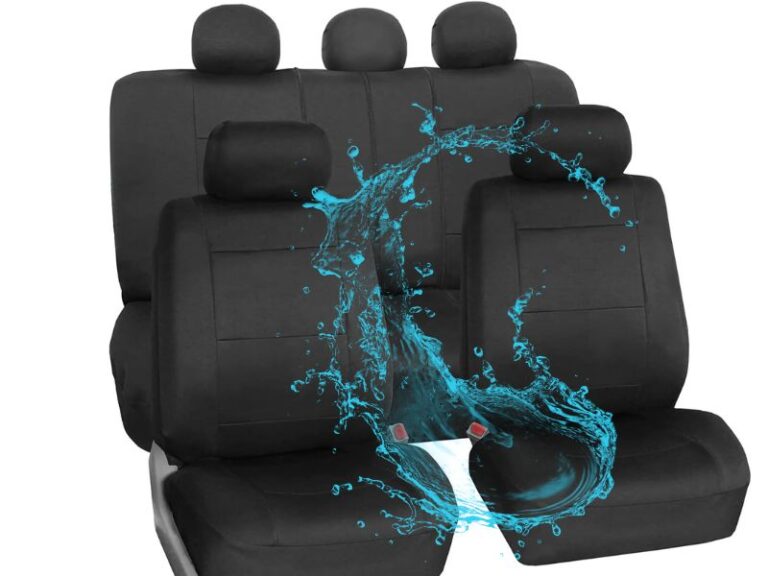Are Neoprene Seat Covers Worth the Hype? Is it Best For You?
As a car owner, one of your main concerns is often maintaining the interior of your vehicle. With regular use, car seats are subject to all kinds of wear and tear—spills, UV damage, dirt, and abrasion from daily usage. Neoprene seat covers have emerged as one of the leading solutions for preserving your car’s interior, thanks to their durability, comfort, and water-resistant properties. But the question remains: Are neoprene seat covers worth the hype?
In this comprehensive guide, we’ll explore everything you need to know about neoprene seat covers, their features, pros and cons, how they compare to other materials like leather and polyester, and whether they offer good value for money. If you’re considering an upgrade for your car’s interior, this article will help you decide if neoprene is the right choice.
What Are Neoprene Seat Covers?

Neoprene is a synthetic rubber material known for its durability, flexibility, and resistance to various environmental factors. Originally developed by DuPont in the 1930s, neoprene is used in a variety of industries, including automotive, medical, and sporting goods. It’s most commonly associated with wetsuits, as it provides excellent water resistance and insulation.
Neoprene seat covers are designed to protect your vehicle’s upholstery from damage caused by spills, dirt, UV rays, and general wear and tear. The material is strong, flexible, and soft, making it ideal for those who need a practical and durable solution for their car’s interior. Unlike traditional fabrics or leather, neoprene is specifically engineered to endure harsh conditions while providing a comfortable experience for drivers and passengers.
The Features of Neoprene Seat Covers
Neoprene seat covers stand out due to several unique characteristics. Let’s take a closer look at the features that make them so popular among car owners.
Durability
Neoprene is renowned for its toughness and long-lasting performance. It can withstand rough treatment, whether from kids, pets, or outdoor gear. The material is resistant to tearing, abrasion, and punctures, making it ideal for active individuals who need reliable protection for their car seats.
Unlike polyester or fabric covers, which can wear out quickly, neoprene is designed to hold up over time. Whether you’re frequently getting in and out of the car or transporting heavy objects, neoprene will maintain its integrity for years.
Waterproofing
One of the standout features of neoprene is its waterproof nature. As the same material used in wetsuits, neoprene is inherently water-resistant, which makes it an excellent choice for car seat covers. Whether you’re dealing with a spilled drink, wet clothing after a swim, or pet messes, neoprene seat covers prevent liquids from seeping into your seats, offering superior protection to the underlying upholstery.
This feature is particularly beneficial for families, pet owners, and outdoor enthusiasts who frequently encounter water, mud, or sweat. The waterproof property also helps prevent the growth of mold or mildew, which can be a problem with fabric or leather seats when moisture seeps into the padding.
Comfort
While neoprene is tough, it’s also surprisingly comfortable. The material has a soft, cushioned feel that adds an extra layer of comfort to your car seats. Many drivers appreciate the added padding, which can make long trips more enjoyable.
Neoprene is also breathable, which means it doesn’t trap heat as much as other materials. This makes it more comfortable in hot weather, as it won’t get as hot or sticky as vinyl, leather, or certain fabric seat covers.
UV Resistance
Prolonged exposure to the sun’s UV rays can wreak havoc on your car’s interior. Seats that are constantly exposed to sunlight can fade, crack, or discolor over time. Neoprene seat covers offer UV resistance, which helps protect your car’s seats from the harmful effects of the sun. This not only keeps your seats looking new but also preserves the resale value of your vehicle by preventing UV-related damage.
Custom Fit
Many neoprene seat covers are available in custom-fit designs, meaning they are tailored specifically to your vehicle’s make and model. This ensures a snug, tight fit that looks sleek and professional, unlike universal-fit covers, which may sag or shift around during use.
Custom-fit neoprene covers provide full coverage, including headrests and armrests, protecting every part of your car’s seats. This precision fit also enhances the overall aesthetic of your car’s interior, making it look clean and well-maintained.
Heat Resistance
In addition to its UV resistance, neoprene has heat-resistant properties. Unlike leather, which can become scorching hot after sitting in the sun, neoprene tends to remain cooler to the touch. This makes it more comfortable to sit on during hot summer months, especially if your car is parked outdoors frequently.
Easy Maintenance
Neoprene seat covers are relatively easy to maintain. The material is resistant to stains and can be wiped clean with a damp cloth. For tougher spills, a mild soap and water solution can usually do the trick. The low-maintenance nature of neoprene makes it ideal for busy individuals who want to keep their car’s interior looking great without the need for frequent deep cleaning.
Pros and Cons of Neoprene Seat Covers

As with any product, neoprene seat covers have both advantages and disadvantages. Below is a breakdown of the pros and cons to help you make an informed decision.
Pros
- Waterproof: Neoprene is completely water-resistant, making it perfect for protecting your seats from spills, sweat, and pet accidents.
- Durability: Neoprene is incredibly tough and resistant to wear, making it an excellent choice for active lifestyles.
- Comfort: The soft, cushioned texture of neoprene adds comfort to your seats, particularly on long trips.
- UV Protection: Neoprene resists fading and cracking caused by exposure to the sun.
- Custom Fit: Many neoprene seat covers are made to fit specific vehicle models, providing a professional, snug appearance.
- Easy to Clean: Neoprene seat covers can be cleaned with minimal effort, often requiring only a quick wipe down.
- Heat Resistant: Neoprene remains cooler than leather or vinyl in hot weather, making it more comfortable in warm climates.
Cons
- Cost: Neoprene seat covers are often more expensive than polyester or vinyl options due to their superior materials and custom fit.
- Maintenance: While easy to clean, neoprene can attract dust and lint more easily than some other materials, meaning it may need more frequent wiping.
- Style Limitations: Neoprene seat covers tend to come in fewer colors and styles than leather or fabric options, limiting customization for those who want a specific aesthetic.
- Initial Smell: Some neoprene covers may have a slight rubbery smell when first installed, though this typically fades over time.
Comparing Neoprene Seat Covers to Other Materials
There are numerous types of seat covers available, including leather, polyester, vinyl, and fabric. So how do neoprene seat covers compare to these other materials? Let’s break it down.
Neoprene vs. Leather
Leather is often seen as the gold standard of luxury in vehicle interiors, but it has its downsides compared to neoprene.
| Feature | Neoprene | Leather |
|---|---|---|
| Comfort | Soft, cushioned, and breathable | Luxurious but can become hot and sticky |
| Durability | Highly durable, resistant to wear | Can crack and fade over time without care |
| Water Resistance | Fully waterproof | Absorbs moisture unless specially treated |
| Maintenance | Easy to clean, wipe down with a damp cloth | Requires regular conditioning and care |
| Aesthetic | Sporty, rugged look | High-end, luxurious appearance |
| Cost | Moderate to high | Expensive, especially for premium leather |
| Heat Resistance | Stays cool in the sun | Can get extremely hot |
Neoprene vs. Polyester
Polyester seat covers are a popular option because of their affordability. However, they fall short in a few key areas when compared to neoprene.
| Feature | Neoprene | Polyester |
|---|---|---|
| Comfort | Soft and padded | Thinner, less padding |
| Durability | Highly durable, resistant to tears | Prone to tearing or wearing out |
| Water Resistance | Fully waterproof | Not water-resistant |
| Maintenance | Easy to clean, though attracts dust | Easier to clean but stains easily |
| Aesthetic | Sporty, rugged look | Basic look, available in more colors |
| Cost | Moderate to high | Affordable |
Neoprene vs. Vinyl
Vinyl seat covers are another affordable option, often used as a budget-friendly alternative to leather. But how do they compare to neoprene?
| Feature | Neoprene | Vinyl |
|---|---|---|
| Comfort | Soft and breathable | Can feel sticky, especially in hot weather |
| Durability | Highly durable | Prone to cracking and peeling over time |
| Water Resistance | Fully waterproof | Water-resistant, but less durable than neoprene |
| Maintenance | Easy to clean | Easy to wipe down but may crack |
| Aesthetic | Sporty, rugged look | Shiny, plasticky appearance |
| Cost | Moderate | Low |
Neoprene vs. Fabric
Fabric seat covers are often chosen for their comfort and breathability, but they can fall short when it comes to durability and protection.
| Feature | Neoprene | Fabric |
|---|---|---|
| Comfort | Soft, cushioned feel | Soft but less cushioned |
| Durability | Highly durable, resistant to tears | Prone to tearing and wearing over time |
| Water Resistance | Fully waterproof | Not water-resistant |
| Maintenance | Easy to clean, wipes easily | Can be hard to clean if stained |
| Aesthetic | Sporty, rugged look | Comes in a variety of textures and colors |
| Cost | Moderate | Low to moderate |
Price Comparison: Neoprene vs. Other Seat Covers
When choosing seat covers, price is an important factor. Neoprene seat covers generally fall into the mid-to-high range, but they offer more value in terms of durability and protection. Here’s a price comparison:
| Material | Price Range (Per Row) | Notes |
|---|---|---|
| Neoprene | $150 – $300 | Custom fit, durable, waterproof, and protective. |
| Leather | $200 – $1000 | Premium option, high-end feel, but requires maintenance and conditioning. |
| Polyester | $50 – $150 | Budget-friendly but lacks durability and water resistance. |
| Vinyl | $75 – $200 | Affordable, but prone to cracking and can feel uncomfortable in hot weather. |
| Fabric | $50 – $200 | Comfortable, but lacks the water resistance and durability of neoprene. |
Who Should Consider Neoprene Seat Covers?

Neoprene seat covers aren’t for everyone, but they are an excellent option for certain types of car owners. You should consider neoprene seat covers if:
- You have an active lifestyle: Whether you enjoy outdoor activities like hiking, biking, or camping, neoprene seat covers can protect your seats from dirt, mud, and moisture.
- You have kids: Parents know that spills and messes are inevitable when kids are involved. Neoprene’s water-resistant properties make it easy to clean up after accidents.
- You have pets: If you frequently travel with pets, neoprene seat covers are ideal for protecting your seats from scratches, fur, and pet accidents.
- You live in a hot or sunny climate: Neoprene’s UV and heat-resistant properties make it a great choice for those living in areas with lots of sunshine.
- You want long-lasting protection: Neoprene’s durability makes it an excellent long-term investment for your car’s interior.
How to Choose the Right Neoprene Seat Covers for Your Vehicle
When shopping for neoprene seat covers, consider the following factors:
- Vehicle Make and Model: Ensure the covers are compatible with your vehicle. Many neoprene covers are custom-fit for specific models.
- Color and Design: While neoprene may not offer as many design options as other materials, choose a color that complements your car’s interior.
- Budget: Neoprene covers range in price, so consider how much you’re willing to spend for durability and protection.
- Installation: Look for covers that are easy to install. Many custom-fit neoprene covers are designed to slip on easily with straps or fasteners.
- Maintenance Needs: Choose covers that are easy to clean and maintain, especially if you expect frequent spills or messes.
How to Maintain and Care for Neoprene Seat Covers
One of the advantages of neoprene seat covers is that they are relatively easy to maintain. Here are some tips for keeping them in top shape:
- Regular Cleaning: Wipe down your neoprene seat covers regularly with a damp cloth to remove dust, dirt, and pet hair. For tougher stains, use a mild soap solution.
- Avoid Harsh Chemicals: Neoprene is durable, but harsh cleaning chemicals can degrade the material. Stick to gentle cleaners.
- Dry Thoroughly: After cleaning, ensure that your seat covers dry completely. Although neoprene is water-resistant, it’s important to avoid trapping moisture underneath the covers.
- UV Protection: If your car is parked outside frequently, consider using a sunshade to protect the covers and reduce fading over time.
- Check for Damage: Inspect your covers regularly for signs of wear or tear. If any damage occurs, address it promptly to prevent further deterioration.
FAQs About Neoprene Seat Covers
Are neoprene seat covers difficult to install?
No, most neoprene seat covers are designed to be easy to install. Custom-fit covers are particularly simple to put on since they are made to match your car’s seats perfectly.
How do you clean neoprene seat covers?
Neoprene seat covers can be cleaned with a damp cloth or sponge. For tougher stains, a mild soap and water solution can be used. Avoid using harsh chemicals, as they may damage the material.
Do neoprene seat covers smell like rubber?
Some neoprene seat covers may have a slight rubbery smell when first installed, but this usually dissipates after a few days of use.
Can neoprene seat covers damage my car seats?
No, neoprene seat covers are designed to protect your seats, not damage them. Their snug fit ensures they don’t shift or cause abrasion to the original upholstery.
Will neoprene seat covers work with heated seats?
Yes, neoprene seat covers are compatible with heated seats. The material does not block the heat from passing through, so your seat warmers will still function as normal.
How long do neoprene seat covers last?
With proper care, neoprene seat covers can last several years. They are highly durable and designed to withstand daily wear and tear, making them a good long-term investment.
Conclusion: Are Neoprene Seat Covers Worth It?
So, are neoprene seat covers worth the hype? The answer depends on your lifestyle and vehicle needs. If you’re looking for seat covers that are durable, waterproof, and comfortable, neoprene offers excellent value for money. Their water resistance makes them ideal for families, pet owners, and outdoor enthusiasts, while their UV protection ensures your seats remain in great condition even in sunny climates.
While neoprene seat covers may be more expensive than some other materials, their durability and protection mean you won’t have to replace them as often, making them a sound investment in the long run. If you want to preserve your car’s interior and enjoy a comfortable ride, neoprene seat covers are definitely worth considering.
- Can I Get in a Taxi Without a Car Seat? - January 26, 2025
- Can I Get Chlamydia From a Toilet Seat? - January 26, 2025
- Can I Get an Uber With a Car Seat? - January 26, 2025






